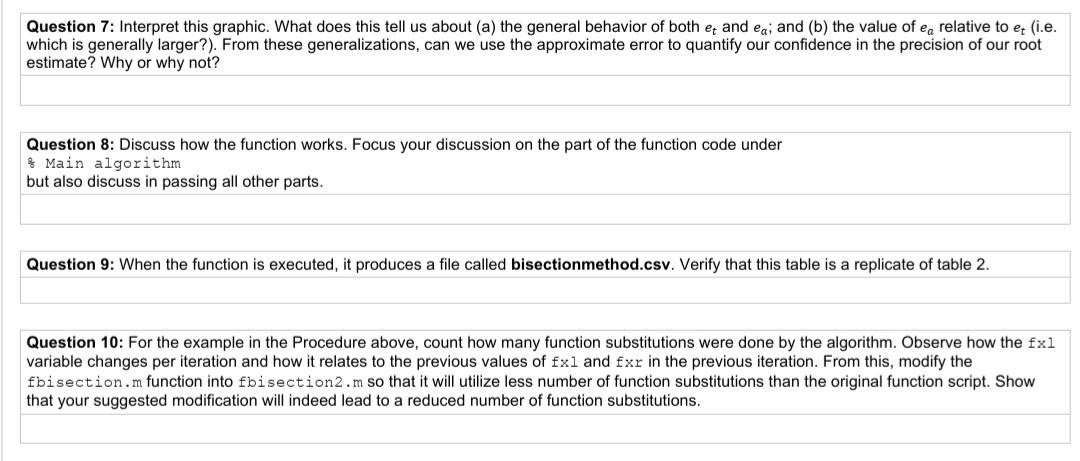Answered step by step
Verified Expert Solution
Question
1 Approved Answer
Instructions: Provide your answers to each of the questions. Provide all the necessary proofs (codes, screenshots of output, graphs, etc.) to support your response for
Instructions: Provide your answers to each of the questions. Provide all the necessary proofs (codes, screenshots of output, graphs, etc.) to support your response for each.

Question 7: Interpret this graphic. What does this tell us about (a) the general behavior of both e, and ea; and (b) the value of ea relative to e: (i.e. which is generally larger?). From these generalizations, can we use the approximate error to quantify our confidence in the precision of our root estimate? Why or why not? Question 8: Discuss how the function works. Focus your discussion on the part of the function code under * Main algorithm but also discuss in passing all other parts. Question 9: When the function is executed, it produces a file called bisectionmethod.csv. Verify that this table is a replicate of table 2. Question 10: For the example in the Procedure above, count how many function substitutions were done by the algorithm. Observe how the fxl variable changes per iteration and how it relates to the previous values of fxl and fxr in the previous iteration. From this, modify the fbisection.m function into fbisection2.m so that it will utilize less number of function substitutions than the original function script. Show that your suggested modification will indeed lead to a reduced number of function substitutions. Question 7: Interpret this graphic. What does this tell us about (a) the general behavior of both e, and ea; and (b) the value of ea relative to e: (i.e. which is generally larger?). From these generalizations, can we use the approximate error to quantify our confidence in the precision of our root estimate? Why or why not? Question 8: Discuss how the function works. Focus your discussion on the part of the function code under * Main algorithm but also discuss in passing all other parts. Question 9: When the function is executed, it produces a file called bisectionmethod.csv. Verify that this table is a replicate of table 2. Question 10: For the example in the Procedure above, count how many function substitutions were done by the algorithm. Observe how the fxl variable changes per iteration and how it relates to the previous values of fxl and fxr in the previous iteration. From this, modify the fbisection.m function into fbisection2.m so that it will utilize less number of function substitutions than the original function script. Show that your suggested modification will indeed lead to a reduced number of function substitutions
Step by Step Solution
There are 3 Steps involved in it
Step: 1

Get Instant Access to Expert-Tailored Solutions
See step-by-step solutions with expert insights and AI powered tools for academic success
Step: 2

Step: 3

Ace Your Homework with AI
Get the answers you need in no time with our AI-driven, step-by-step assistance
Get Started


